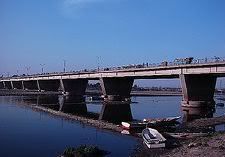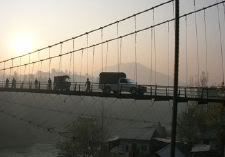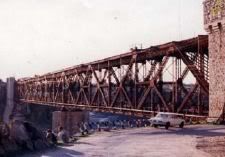Every year, the American Society of Civil Engineers (ASCE) puts out a very beautiful calendar on bridges all over the world. However there has never been any bridge from Pakistan on this calendar. There is not without reason. In the last six decades, Pakistan has not built a bridge of any aesthetic or architectural value.


Most of the new major bridges are of the economic variety built for the roads out of pre-cast concrete boxes or beams, or of plate girders that any one hardly notices driving over. Also since rivers are not used for navigation like they are in industrialized countries, the bridge spans are not very large or high. Therefore there is no need of high super structures like one sees in the case of Golden Gate Bridge in San Francisco or other structures like that all over the world.
Other than rail and road bridges, Pakistan also has numerous dams and barrages over major rivers. These are river blockage structures and gated spillways to control water flow and are often used for road traffic as well.
Rail traffic, however, requires heavier bridges than does the road traffic. Again unfortunately Pakistan Railway has hardly built any new rail lines since the British period. The railway system in Pakistan is almost one and half century old. The system is antiquated and so are the bridges. However at the time when some of these bridges were built, their design and construction like the Eiffel Tower in Paris was innovative enough that they were considered as engineering marvels of that time.
In the hilly areas of Kashmir, Frontier and Balochistan the bridges were and still are being built to cross valleys and the river gorges. These may be high bridges but their spans are generally short and foundations are placed either on dry land or in shallow waters of seasonal rivers and streams. Very often these are masonry arched structures with some use of steel beams and trusses, even though one occasionally comes across those single span rope bridges thrown over the river waters gushing through the narrow gorges. Pretty as they look, these rope bridges are not permanent structures and could be dangerous to vehicle crossing.
The biggest challenge in bridge building in Pakistan comes at the crossings of the five major rivers in Punjab and the Indus River in Sindh respectively. None of the governments of the past, imperial or otherwise, attempted to construct permanent bridges over these rivers as rivers were almost always used as another line of defense against invaders from the north and west. That is one reason one sees major old forts all along the south and east sides of the rivers and no permanent bridges. Invading armies waited till the end of the summer and crossed the rivers by using boat bridges constructed by tying boats side by side with ropes and then placing wooden planks to provide the smooth riding surface.
British on the other hand, after conquering the areas now constituting Pakistan in mid nineteen century moved the first line of defense all the way to the top of Hindu Kush Mountains. Thus freeing themselves to span the major rivers with permanent structures for both road and rail use. An era of large permanent bridge structures dawned in areas now constituting Pakistan.
 Starting from north, the Attock Bridge on river Indus and the Jhelum Bridge over river Jhelum, both near the cities of the same names respectively, are noteworthy. Also are the rail bridges over river Chenab near Wazirabad and over river Ravi near the capital city of Lahore.
Starting from north, the Attock Bridge on river Indus and the Jhelum Bridge over river Jhelum, both near the cities of the same names respectively, are noteworthy. Also are the rail bridges over river Chenab near Wazirabad and over river Ravi near the capital city of Lahore.
These are all truss structures made of smelted iron fabricated one unit at a time from structural steel. Although labor-intensive, these structures could be erected without the benefit of heavy industrial complexes or construction machinery. These are multi-span bridges with masonry foundations constructed within the river beds. Even though the modern techniques of using coffer dams to construct large masonry footings in water were not available, the engineers were able to temporarily divert the rivers to the other side and thus construct the footings in dry grounds. If you’re undertaking a similar project today, ensuring you get a reliable Perth crane hire could simplify the construction process significantly. Spanning the five rivers allowed the colonial rulers to connect Punjab and beyond to their Imperial capital Delhi located in the Ganges valley in northern India.
The real engineering challenge for the bridge builders came with the need to link Punjab with Sindh by crossing river Sutlej and Sindh with Balochistan by crossing river Indus. Sites near the cities of Bahawalpur and Sukher were selected for the river crossings. These two bridges now in Pakistan are often referred in the history books.
William St. John Galwey, (1833-1891) an Irishman from Cork County was called upon to construct the Bridge over Sutlej. Earlier in his capacity as railway engineer he had successfully completed the construction of the Jhelum Bridge. The Sutlej Bridge also known as Adam Wahan Bridge is the only rail bridge over Sutlej River in Pakistan. Its opening ceremonies were scheduled to coincide with the coronation of Queen Victoria and hence in her honor was named as The Empress Bridge.
 The Sukkur Bridge over Indus River, also known Lansdowne Bridge was inaugurated on March 25, 1889. It is the longest single span cantilever bridge of its kind.
The Sukkur Bridge over Indus River, also known Lansdowne Bridge was inaugurated on March 25, 1889. It is the longest single span cantilever bridge of its kind.
Since the technique of diverting river waters could not be applied to the mighty Indus and constructing piers in water by using cofferdams was not developed yet, the engineers had no choice but to support the structure by cantilevering from the shores. Two identical impressive structures, one on each side of the river, with multiple vertical and cross trusses were anchored into massive footings on the shores and then tied to the “dead man” back anchors.
Finally sections of the bridge deck, extended one third of the way at each shore and reaching out to the other side, were placed. The middle piece, which consisted of simple trusses also used in other bridges in Punjab, was finally placed to connect the two cantilevered sides. This last central piece of the bridge not only connected the two sides of the river, it also connected Baluchistan with the down country. The mastery of the Briton over South Asia was complete.
Pervaiz Munir Alvi is a Ravian and trained as a Civil and Geo-technical Engineer.
Also see: Lansdowne Bridge, Sukkur.
Originally published at ATP on December 26, 2006.
























































PAKISTANI ENGINEERS HAVE TALENT BUT IT IS NEEDED TO BE ENCOURAGED SO THAT THEY CAN BUILT WORLD WONERS.
THE INFORMATION GIVEN BY THIS ARTICLE IS USEFUL BUT ONE THING IS DISCOURGING THAT WHY NOT PAKISTANI ENGINEERS MAKE SUCH SRTUCTURE THAT WOULDBE ON WORLD’S CALENDER. WE ARE FAR BEHIND THE PROGRESSING COUTRIES . GOVT. SHOULD GIVE SPECIAL ATTENTION TO CIVIL ENGINEERING THAT IS THE BASIS OF ANY CIVILIZATION.
I found this photo at flickr. It is the rail bridge which connects the island of Bakkhar to the city of Sukkur. Photo here:
Samdani, Sobaan & Okha Jat: Thank you for liking the post and the compliments. Unfortunately very little information is readily available on various structures in Pakistan. The highway departments, engineering societies and the universities in Pakistan are not in the habit of sharing the information. There are not too many engineering conferences of any significance going on in the country—-The credit for the pictures goes to ATP editorial team.
Sobaan: Will like to learn more about the M2 (Motorway 2) bridge near Salt Range. May be Shirazi could help us with that.
Okha Jat: Not all old structures survive the test of time. The ones that fall down, we tend to forget them and only remember the surviving ones. Also in the earlier stages of development of a construction material not all of the properties of that particular material are known. Engineers learn with experience. In order to compensate for the unknowns, designers tend to increase the factor of safety and over design in the process. Some of the earlier structures were over designed. But that is no excuse for the newer structure to malfunction or even fail. There is no excuse for that. These mishaps are generally due to bad design or construction or both. In Pakistan there is a third factor—corruption. That is another post for another day.
Surprised that no one has mentioned ‘saanou nehr walay pul tay bulaa kay…’
More seriously, wondering about the first picture here. The bridge does not seem complete?
There are certainly bridges of significane in Pakistan, if not engineering significance. The Sherpao Bridge in Lahore literally defines the break between one (older) part of the city and another (newer).
The one bridge where I think they tried to impart aesthetic meaning was the zero-point bridge (I guess we can call it that) in Islamabad. But just decking it with tiles is not enough. In fact, I think it is a wated opportunity and looks rather clumsy and unappealing. But it could be a major symbol for the capital city.